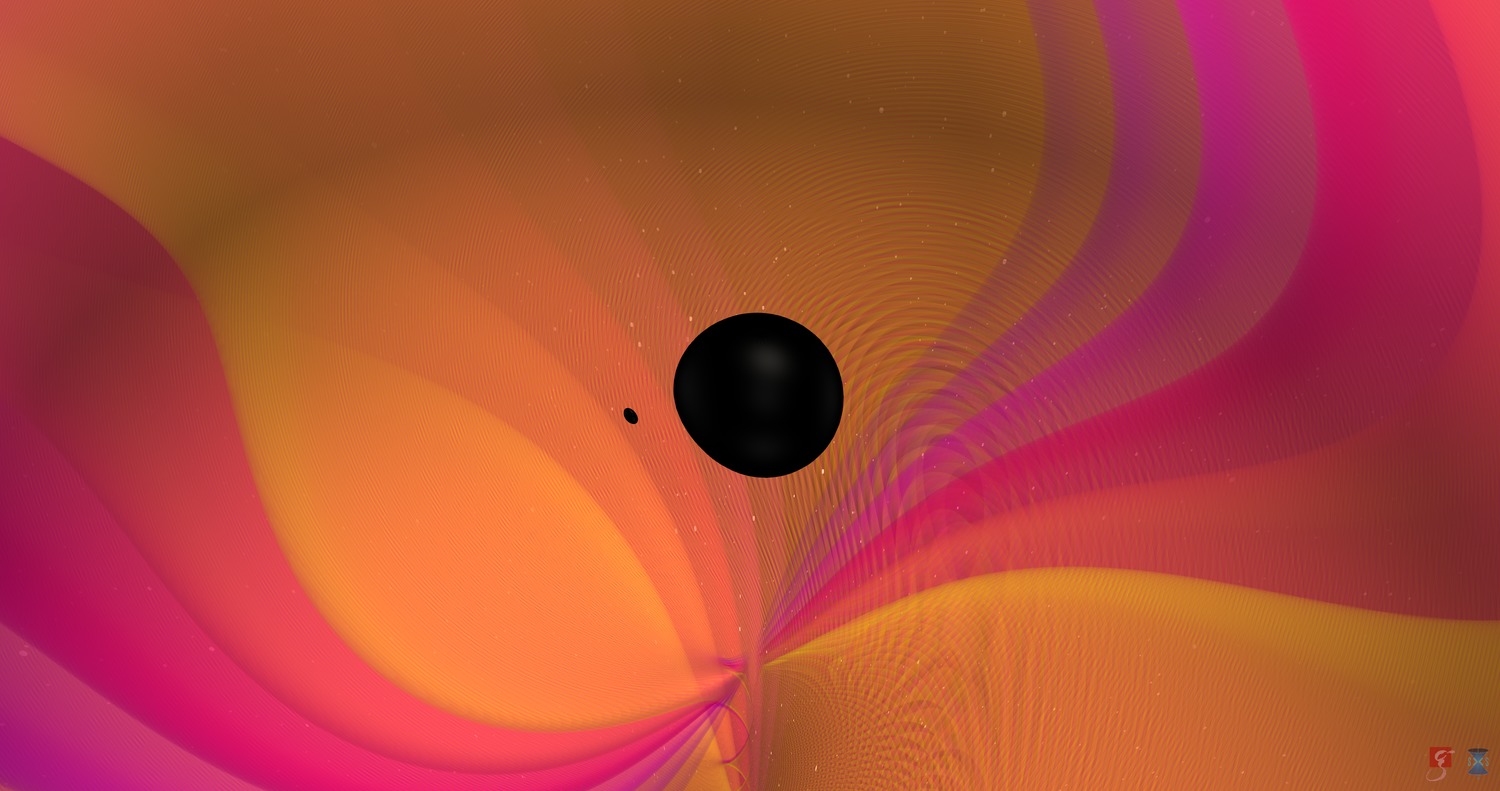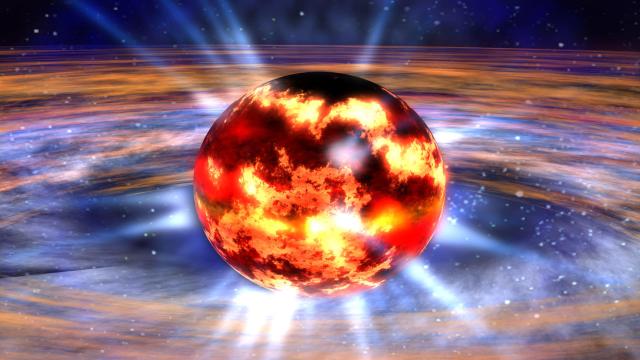Astronomers are puzzling over observations that show a black hole smashing into a mystery object of unusual size.
New research published in The Astrophysical Journal Letters describes a collision between a black hole and a yet-to-be identified object. At the time of this celestial tryst, the black hole was 23 times more massive than our Sun, but the unknown object was just 2.6 times the Sun’s mass, which is distinctly weird.
The scientists behind the new paper, co-authored by astrophysicist Vicky Kalogera from Northwestern University, say the smaller object could be a black hole or a neutron star, the latter of which is the super-dense remnant of an exploded star. A black hole of 2.6 solar masses would be the smallest on record (the lightest known black hole is 5 solar masses), while a neutron star of the same mass would be the biggest on record (the heaviest neutron stars are between 2.3 and 2.4 solar masses). So either way, it’s not something astronomers have ever seen before — and in fact, it could represent an entirely new class of dense, compact objects.
“This discovery is shocking because we found an object with a mass we did not expect,” explained Imre Bartos, an astrophysicist at the University of Florida and a co-author of the new study, in an email to Gizmodo. This range of compact objects, between 2 and 2.5 solar masses, was “thought to be uninhabited until now,” he said, in reference to an enigmatic weight class known as the mass gap.
“In my opinion, the most intriguing part of this study is the detection of an object in the ‘mass gap,’ which is a sort of no-man’s-land between the heaviest neutron star and lightest black hole masses we’ve measured,” Thankful Cromartie, an astrophysicist at the University of Virginia and the National Radio Astronomy Observatory who wasn’t involved with the new study, wrote in an email to Gizmodo. “Unfortunately, it’s impossible to say which it is, partially because the ‘tidal deformation,’ or neutron star stretching, that’s usually detectable in neutron star mergers is drowned out by this merger’s asymmetry.”
That said, the available observational evidence and theoretical predictions of acceptable neutron star masses “indicate that this object is most likely to be a very light black hole,” she said. If this turns out to be a bona fide neutron star, “we’d have to very radically reconsider the way matter behaves at extremely high densities.”
Astronomers have previously witnessed black hole on black hole action, and even neutron stars smashing into other neutron stars, but not a black hole colliding with a neutron star. If confirmed, this cosmic merger, designated GW190814, would be the first. Gizmodo wrote about preliminary research into this event last summer.
GW190814 was spotted on August 14, 2019 by the National Science Foundation’s Laser Interferometer Gravitational-Wave Observatory (LIGO) and the Virgo detector. This merger, located 8 million light-years from Earth, was so momentous that it created ripples in the fabric of space-time, which radiated outwards in the form of gravitational waves that eventually reached detectors on Earth (thanks Einstein!). The discrepancy in mass of the two objects, at a ratio of 9:1, represents a new extreme for a gravitational wave event. The prior mass disparity record belonged to GW190412 — a collision involving two black holes — which featured a 4:1 mass ratio.
Previous cosmic mergers involving neutron stars, like GW170817 from August 2017, produced detectable light waves in addition to gravitational waves, but no light was detected from this merger, despite the fact that several observatories around the world were trained on the spot after LIGO and Virgo scientists sent out an alert. It’s possible, the authors say, that the light from GW170817 was too faint given the vast distances involved. Or, the unknown object was a black hole, albeit a surprisingly underweight black hole. The researchers suggest another possibility: It was a neutron star that was gobbled by the black hole in one big gulp, in a rapid merger that produced no light.

Excitingly, and as Charlie Hoy, a member of the LIGO Scientific Collaboration and a graduate student at Cardiff University, said in a press release: “This is the first glimpse of what could be a whole new population of compact binary objects.”
Cromartie said the lighter object is unlikely to be a neutron star, “despite how exciting that result would be.” We’re not currently able to know either way, “but it’s important not to expend too much energy on considering that possibility,” as the LIGO team has explicitly stated that it’s not likely, she said.
The origin of the lighter object, with its 2.6 solar masses, remains another mystery. Both neutron stars and black holes are born when massive stars collapse under their own gravity, said Bartos, but the new object is “inconsistent with this evolution, so something must have created it other than a dying star.”
One interesting possibility, said Bartos, is that this object emerged from the collision of two “normal-sized” neutron stars, which tend to weigh around 1.3 solar masses, “so two of those can nicely make up the mass we observe here,” he told Gizmodo. To which he added:
The fact that such a collision was then followed by the remnant’s collision with a black hole suggests that there is some sort of “assembly line” at play here. This is actually expected in the universe in places where there are a lot of black holes and neutron stars in close proximity. This is the case in the centre of every galaxy where these objects migrate due to the attraction of the central supermassive black hole that is found in basically every galaxy. It can also help if something facilitates the collisions, like a large influx of gas that forms a disk around the supermassive black hole, and then collects and assembles the smaller black holes and neutron stars. Actually, the other big surprise about this event, the very different masses of the two colliding objects, is also pointing towards a violent encounter.
The next step will be to confirm and study more cosmic mergers. The good news is that more detections are expected in the coming months and years, as our astronomical instruments steadily improve.
“The rate of discoveries is accelerating — this was only the third collision published by LIGO and Virgo out of over 50 candidates that we are still analysing,” Bartos told Gizmodo. In the coming years, the rate of discoveries will further increase by a sizable factor, he said, “so we can expect more exciting detections” on a practically daily basis. Which, wow.
This article has been updated since its original publication.
